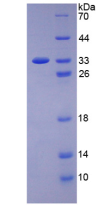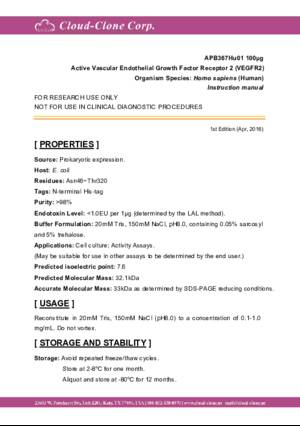Active Vascular Endothelial Growth Factor Receptor 2 (VEGFR2)
CD309; FLK1; VEGFR; KDR; A Type III Receptor Tyrosine Kinase; Kinase Insert Domain Receptor; Kinase Insert Domain Receptor; Fetal Liver Kinase-1
- Product No.APB367Hu01
- Organism SpeciesHomo sapiens (Human) Same name, Different species.
- Buffer Formulation20mM Tris, 150mM NaCl, pH8.0, containing 1mM EDTA, 1mM DTT, 0.01% SKL, 5% Trehalose and Proclin300.
- Traits Freeze-dried powder
- Purity> 97%
- Isoelectric Point7.6
- ApplicationsCell culture; Activity Assays.
- DownloadInstruction Manual
- UOM 10µg50µg 200µg 1mg 5mg
- FOB
US$ 180
US$ 450
US$ 900
US$ 2700
US$ 6750
For more details, please contact local distributors!
ACTIVITY TEST
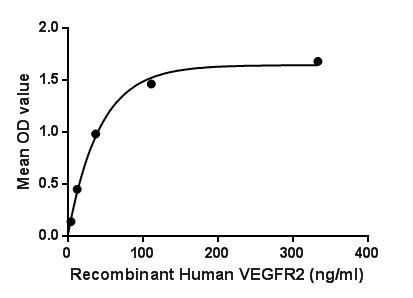
Figure. The binding activity of VEGFR2 with VEGFC.
Vascular Endothelial Growth Factor Receptor 2 (VEGFR2) also known as kinase insert domain receptor is a VEGF receptor. There are three main subtypes of VEGFR, numbered 1, 2 and 3. All members of the VEGF family stimulate cellular responses by binding to VEGF receptors on the cell surface, causing them to dimerize and become activated through transphosphorylation. VEGFR2 appears to mediate almost all of the known cellular responses to VEGF. Besides, Vascular Endothelial Growth Factor C (VEGFC) has been identified as an interactor of VEGFR2, thus a binding ELISA assay was conducted to detect the interaction of recombinant human VEGFR2 and recombinant human VEGFC. Briefly, VEGFR2 were diluted serially in PBS, with 0.01% BSA (pH 7.4). Duplicate samples of 100uL were then transferred to VEGFC-coated microtiter wells and incubated for 2h at 37℃. Wells were washed with PBST and incubated for 1h with anti-VEGFR2 pAb, then aspirated and washed 3 times. After incubation with HRP labelled secondary antibody, wells were aspirated and washed 3 times. With the addition of substrate solution, wells were incubated 15-25 minutes at 37℃. Finally, add 50µL stop solution to the wells and read at 450nm immediately. The binding activity of VEGFR2 and VEGFC was shown in Figure 1, and this effect was in a dose dependent manner.
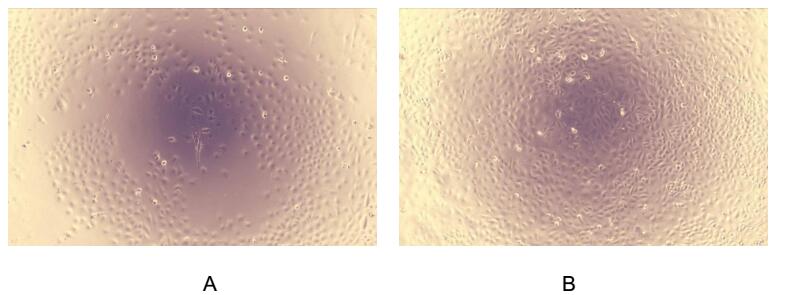
Figure. Cell proliferation of ECV-304 cells inhibit by VEGFR2.
Vascular Endothelial Growth Factor Receptor 2 (VEGFR2) also known as kinase insert domain receptor acts as a cell-surface receptor for VEGFA, VEGFC and VEGFD. VEGFR2 functions as the primary mediator of vascular endothelial growth factor activation in endothelial cells. Regulation of VEGFR-2 expression appears critical in mitogenesis, differentiation, and angiogenesis. To test the effect on inhibit the VEGF-dependent proliferation of endothelium cells, ECV-304 cells were seeded into triplicate wells of 96-well plates at a density of 5,000 cells/well and allowed to attach, replaced with serum-free overnight, then the medium was replaced with 2% serum standard DMEM including 1μg/mL Vascular Endothelial Growth Factor C (VEGFC) and various concentrations of recombinant human VEGFR2. After incubated for 96h, cells were observed by inverted microscope and cell proliferation was measured by Cell Counting Kit-8 (CCK-8). Briefly, 10µL of CCK-8 solution was added to each well of the plate, then the absorbance at 450nm was measured using a microplate reader after incubating the plate for 1-4 hours at 37℃. Proliferation of ECV-304 cells after incubation with VEGFR2 for 96h observed by inverted microscope was shown in Figure 2. Cell viability was assessed by CCK-8 (Cell Counting Kit-8 ) assay after incubation with recombinant VEGFR2 for 96h. The result was shown in Figure 2. It was obvious that VEGFR2 significantly inhibit cell viability of ECV-304.
(A) ECV-304 cells cultured in DMEM, stimulated with 10ng/mL VEGFR2 for 96h;
(B) Unstimulated ECV-304 cells cultured in DMEM for 96h.
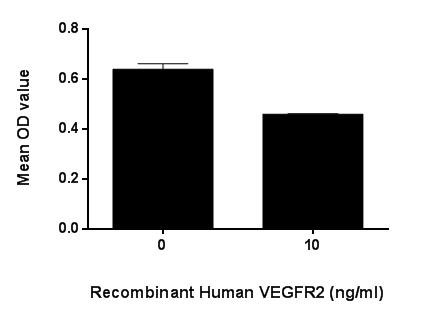
Figure. VEGFR2 inhibit VEGF-dependent proliferation of ECV-304 cells.
USAGE
Reconstitute in 20mM Tris, 150mM NaCl (pH8.0) to a concentration of 0.1-1.0 mg/mL. Do not vortex.
STORAGE
Avoid repeated freeze/thaw cycles. Store at 2-8°C for one month. Aliquot and store at -80°C for 12 months.
STABILITY
The thermal stability is described by the loss rate. The loss rate was determined by accelerated thermal degradation test, that is, incubate the protein at 37°C for 48h, and no obvious degradation and precipitation were observed. The loss rate is less than 5% within the expiration date under appropriate storage condition.
GIVEAWAYS
INCREMENT SERVICES
-
 BCA Protein Quantification Kit
BCA Protein Quantification Kit
-
 Molecular Mass Marker for Protein
Molecular Mass Marker for Protein
-
 Monoclonal Antibody Customized Service
Monoclonal Antibody Customized Service
-
 Polyclonal Antibody Customized Service
Polyclonal Antibody Customized Service
-
 Protein Activity Test Experiment Service
Protein Activity Test Experiment Service
-
 Electrophoretic Mobility Shift Assay (EMSA) Experiment Service
Electrophoretic Mobility Shift Assay (EMSA) Experiment Service
-
 Buffer
Buffer
-
 Lentivirus Packaging Experiment Service
Lentivirus Packaging Experiment Service
-
 Adenovirus Packaging Experiment Service
Adenovirus Packaging Experiment Service
-
 Real Time PCR Experimental Service
Real Time PCR Experimental Service
-
 Spike RBD Protein (S-RBD)
Spike RBD Protein (S-RBD)
-
 Protein G
Protein G
-
 Protein A
Protein A
| Magazine | Citations |
| APMIS | Peritumoral brain edema in angiomatous supratentorial meningiomas: an investigation of the vascular endothelial growth factor A pathway PubMed: 23398358 |
| Acta Biomater | Antioxidant and bone repair properties of quercetin-functionalized hydroxyapatite: an in vitro osteoblast-osteoclast-endothelial cell co-culture study PubMed: 26689470 |
| Acta Biomaterialia | Antioxidant and bone repair properties of quercetin-functionalized hydroxyapatite: An in vitro osteoblast–osteoclast–endothelial cell co-culture study Pubmed:26689470 |
| Journal of Cellular Physiology | A Human 3D In Vitro Model to Assess the Relationship Between Osteoporosis and Disseminationto Bone of Breast Cancer Tumor Cells. pubmed:27925188 |
| Regenerative Biomaterials | The directional migration and differentiation of mesenchymal stem cells toward vascular endothelial cells stimulated by biphasic calcium phosphate ceramic 10.1093/rb/rbx028 |
| International Journal of Immunopathology and Pharmacology | VEGF-R2 and TNF-R1 expression and cytokine production by samples of mammary adenocarcinomas and correlations with histopathological parameters of these … Pubmed:29985074 |
| JOURNAL OF DERMATOLOGICAL TREATMENT | Effect of isotretinoin (13-cis-retinoic acid) on levels of soluble VEGF receptors (sVEGFR1, sVEGFR2, sVEGFR3) in patients with acne vulgaris Pubmed: 32043381 |
| Journal of Genetic Engineering and Biotechnology | Encapsulated VEGF 121-PLA microparticles promote angiogenesis in human endometrium stromal cells 33523322 |
| Mol Cell Biochem | Intuitive repositioning of an anti-depressant drug in combination with tivozanib: precision medicine for breast cancer therapy 34324118 |
| BMC Nephrol | Effect of subacute poisoning with lambdacyhalothrin on vascular endothelial growth factor 2 receptor in mice kidneys Pubmed:35643467 |



